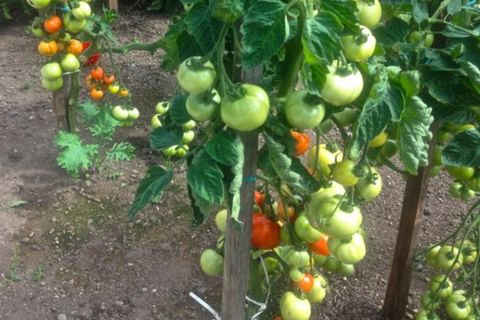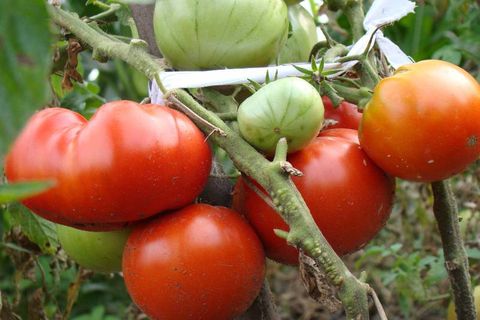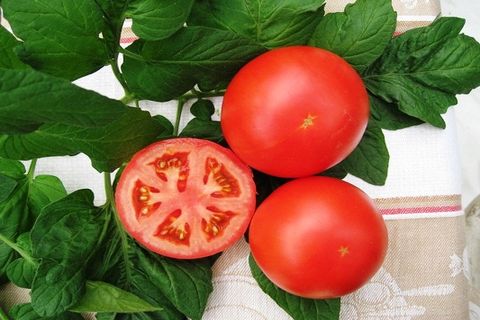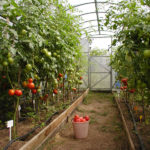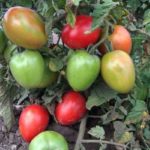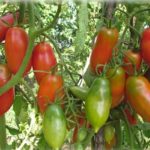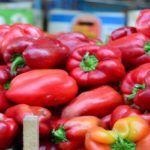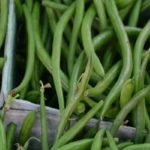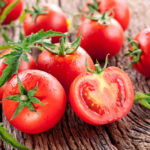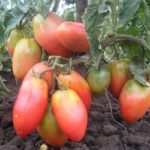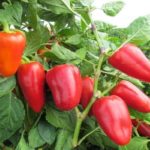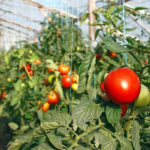Growing tomatoes has long become commonplace even in regions with harsh climates, because thanks to the work of breeders, new, unpretentious, but high-yielding varieties are appearing. Such as the new hybrid - Lev Tolstoy tomato.
Characteristics of the variety
Tomato Lev Tolstoy F1 is available for cultivation in almost all regions, either in the ground or in greenhouses. Since the variety is a hybrid, seeds obtained from the fruit will not give a similar result - they must be purchased at gardening stores.
The plant forms a determinate bush, the height of which is more than 100 centimeters. In a greenhouse, the plant can stretch out, but in open ground it will be compact.Landscaping is average. It is not necessary to form a bush of this variety, but it is better to tie up branches with fruits so that they do not break off.
An early variety of tomatoes, ripens in 110 days. Unripe tomatoes can be ripened well at home without losing their taste. Periodic collection of unripe fruits contributes to the formation of new ovaries and obtaining a larger harvest. In general, the yield of one bush is 3–4 kilograms.
The fruits have a round, slightly flattened shape, with slight ribbing. The weight of one tomato can reach 500 grams. More often, such fruits are formed on the lower branches, and tomatoes weighing 200–300 grams are formed on the upper ones.
Tomatoes of this variety are covered with a dense, but not hard skin, which gradually acquires a rich red color, like the juicy pulp. Inside there are 5 – 6 chambers, which contain a small amount of seeds.
The taste of tomatoes of this variety is sweet, almost without sourness, pleasant, with slight fruity notes. The harvest period can be extended over the entire season. The fruits store well and can be used both fresh and in various preparations.
Advantages and disadvantages of the variety
Reviews of the variety among gardeners are mostly positive, which is illustrated by active purchases of seeds in stores. The popularity of Lev Tolstoy tomatoes is explained by a number of advantages:
- high productivity;
- unpretentiousness to growing conditions;
- versatility of fruit use;
- resistance to diseases - blossom end rot, fusarium, cladosporiosis and others;
- no need to form a bush;
- pleasant taste and large fruit size.
Among the disadvantages is the need for soil: if the fertilizer content is low, the plant produces small fruits and the yield decreases.
The variety is heat-loving - in areas with cold summers it is better to plant tomatoes in greenhouses. Not resistant to late blight, from which plants need to be treated regularly.
Features of cultivation
It is better to grow Lev Tolstoy hybrid tomatoes using seedlings. Seeds are sown in boxes at the end of February - beginning of March, and at the beginning of May they are moved to the greenhouse. Before planting in open ground, it is advisable to harden the bushes so that they form more compactly.
For planting, use a soil mixture (you can use store-bought):
- a small amount of garden soil;
- humus;
- peat;
- river sand.
Seeds of this variety sown in the ground are well sprayed with settled warm water and covered with film to reduce evaporation.
For these purposes, you can use a mini-greenhouse. The emerging seedlings are opened and exposed to light, protected from direct sunlight. Watering is carried out moderately, it is recommended to alternate it with careful loosening.
When warm days arrive, seedlings can be planted in the ground. In different regions this period occurs at different times, usually May - June. Plants are planted at a distance of about 35 centimeters from each other, having treated the soil with a weak solution of potassium permanganate as a preventive measure. At first, it is advisable to cover the bushes from excessive sun and wind - after a few days the protection is removed.
The soil between seedlings can be mulched, for example, with a peat mixture, which will simplify care and reduce water evaporation. Watering is carried out evenly, avoiding stagnation of water in the soil.Fertilizing is done every 3 - 4 weeks; it is recommended to alternate organic and mineral fertilizers. A couple of times during the season, you can treat the bushes with a superphosphate solution, which will help speed up the formation of new ovaries and improve the taste characteristics.
Reviews on growing the Lev Tolstoy variety
Ivan L., Volgograd: “Tomatoes are one of my favorite vegetables; in the garden I grow more than 100 roots of varieties 6 - 8. Among them are large ones for salads, and small ones for pickling. The Lev Tolstoy variety is one of my favorites. I like that it gives a good harvest throughout the season, and I always have fresh tomatoes on the table from July to September.”
Ekaterina M., Simferopol: “Our summer is warm and lasts a long time, so it seems stupid to me not to take advantage of this and not plant vegetables in the garden. I enjoy harvesting and preparing for the winter, and then I take jars out of the cellar and treat them to guests. This year I heard good reviews about Lev Tolstoy tomatoes and decided to try them. I was satisfied: the plants were unpretentious, there was no need to fight diseases, the harvest was good, and the tomatoes themselves were delicious. The whole family enjoyed the fresh fruits. Next year I’ll plant more.”
Vladimir M., Shubino: Every year I buy new varieties of tomatoes and grow them separately. Some I like and buy their seeds for next season, but some don’t pass the test. Lev Tolstoy's tomatoes left an average impression. On the one hand, they have good yield and keeping quality, but on the other hand, they are demanding on the soil and do not like frost. It is better to grow these tomatoes in greenhouses. Nevertheless, I received a harvest, albeit less than I expected.”
Vasilisa N., Oktyabrsk: “I liked the Lev Tolstoy variety for its keeping quality and pleasant taste.Having collected the fruits in September, I was still able to prepare fresh salads until mid-November, which is very valuable in our region. After looking at the descriptions, I found out that the variety has good nutritional value due to its high content of carotene and microelements. This is a good source of nutrients for my family.”

